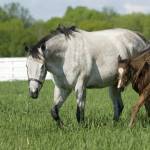Optimal Growth: The Importance of Monitoring Growth Rate

Optimal growth rate results in a desirable body size at a specific age with the fewest number of developmental problems.
Managing the growth in horses becomes a balance between producing a desirable individual for a particular purpose without creating skeletal problems that will reduce a horses’ subsequent athletic ability. Growing a foal too slowly results in the risk of it being too small at a particular age or never obtaining optimal mature body size. Growing a foal too quickly results in the risk of developmental orthopedic disease (DOD) such as epiphysitis, angular limb deformities and osteochondritis dissecans (OCD).
It is now commonly accepted that excess dietary energy intake can lead to rapid growth and increased body fat, which is thought to increase the incidence of certain types of DOD in Thoroughbred foals. Thoroughbred yearlings in a Kentucky study that showed OCD of the hock and stifle were large at birth, grew rapidly from three to eight months, and were heavier than the average population as weanlings.
A European research group reported that warmblood foals that developed fetlock OCD were significantly lighter at 3–7 months of age and those with hock and stifle OCD had higher body weights in the fourth and fifth months of life. Another report from the UK showed that weanlings fed 130% energy requirement had a significantly higher incidence of dyschondroplasia joint lesions than control weanlings, without any change in growth rate.
In addition to rapid growth rates, fluctuating growth rates with periods of slow or decreased growth and growth spurts due to dietary and environmental stress and season can also contribute to DOD.
Because growth in horses is a balancing act, it has been widely recommended to maintain a steady growth rate by regularly weighing and measuring horses during the growth period. As there is no single growth rate that is desirable for all types of horses, horses should be managed differently for varying growth rates depending on breed and intended career.








